Comprehensive Report: Nestle S.A. Business Environment and Operations
VerifiedAdded on 2023/04/07
|15
|3233
|157
Report
AI Summary
This report provides a comprehensive analysis of Nestle S.A.'s business environment. It begins with an introduction to the company, its history, and global presence. The report then delves into Nestle's organizational purposes, examining its matrix structure, management levels, and stakeholder objectives, including internal, connected, and external stakeholders. It assesses Nestle's compliance with stakeholder objectives and its corporate social responsibilities, including environmental, social, management, ethics, and business responsibilities. The report further explores the national environment in which Nestle operates, including economic systems, fiscal and monetary policies, competition policies, and regulatory mechanisms. Finally, it examines Nestle's market environment, focusing on market structures, pricing and output decisions, and the influence of market forces on organizational responses. The report highlights how market forces like supply and demand shape Nestle's operations, and how competition policies impact the company's strategies.
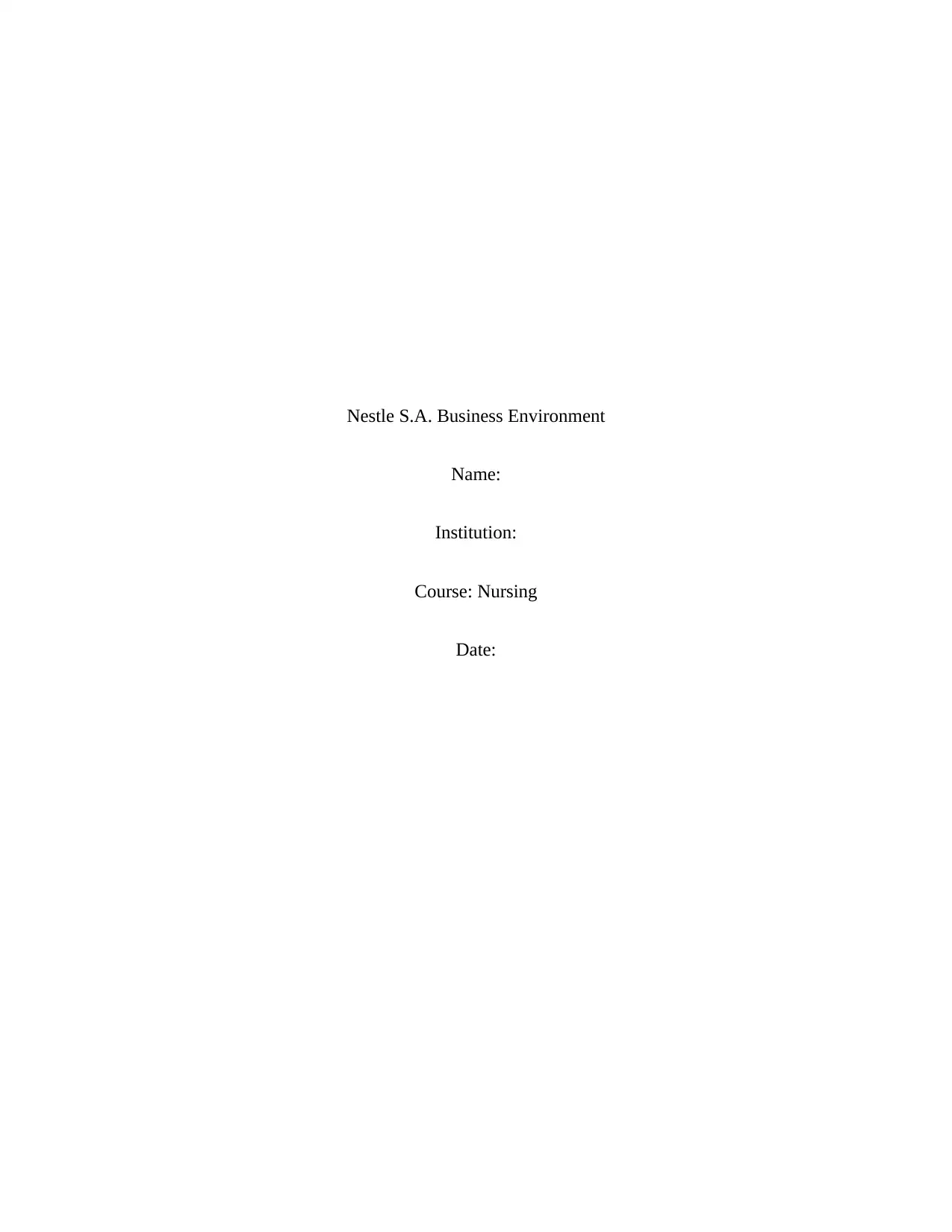
Nestle S.A. Business Environment
Name:
Institution:
Course: Nursing
Date:
Name:
Institution:
Course: Nursing
Date:
Paraphrase This Document
Need a fresh take? Get an instant paraphrase of this document with our AI Paraphraser
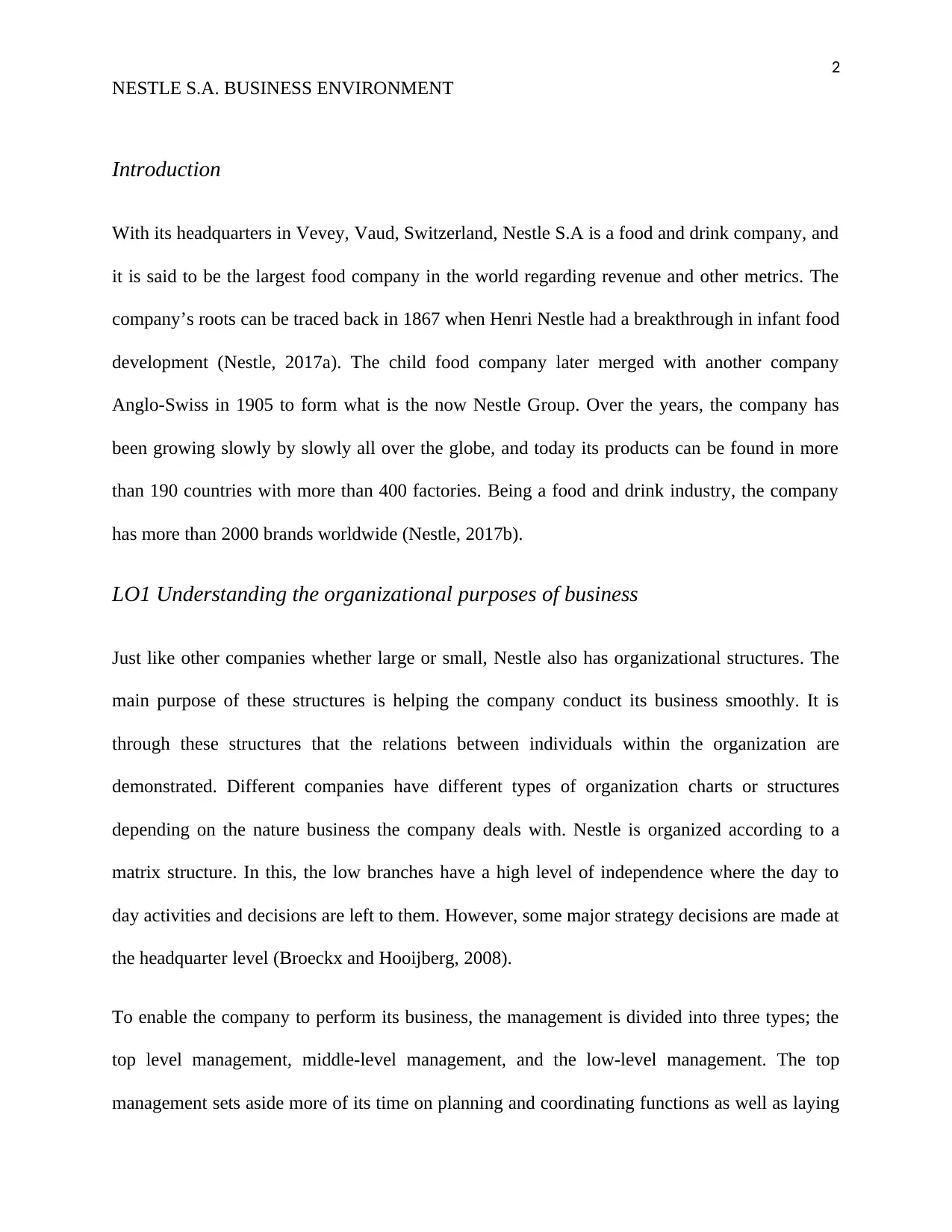
2
NESTLE S.A. BUSINESS ENVIRONMENT
Introduction
With its headquarters in Vevey, Vaud, Switzerland, Nestle S.A is a food and drink company, and
it is said to be the largest food company in the world regarding revenue and other metrics. The
company’s roots can be traced back in 1867 when Henri Nestle had a breakthrough in infant food
development (Nestle, 2017a). The child food company later merged with another company
Anglo-Swiss in 1905 to form what is the now Nestle Group. Over the years, the company has
been growing slowly by slowly all over the globe, and today its products can be found in more
than 190 countries with more than 400 factories. Being a food and drink industry, the company
has more than 2000 brands worldwide (Nestle, 2017b).
LO1 Understanding the organizational purposes of business
Just like other companies whether large or small, Nestle also has organizational structures. The
main purpose of these structures is helping the company conduct its business smoothly. It is
through these structures that the relations between individuals within the organization are
demonstrated. Different companies have different types of organization charts or structures
depending on the nature business the company deals with. Nestle is organized according to a
matrix structure. In this, the low branches have a high level of independence where the day to
day activities and decisions are left to them. However, some major strategy decisions are made at
the headquarter level (Broeckx and Hooijberg, 2008).
To enable the company to perform its business, the management is divided into three types; the
top level management, middle-level management, and the low-level management. The top
management sets aside more of its time on planning and coordinating functions as well as laying
NESTLE S.A. BUSINESS ENVIRONMENT
Introduction
With its headquarters in Vevey, Vaud, Switzerland, Nestle S.A is a food and drink company, and
it is said to be the largest food company in the world regarding revenue and other metrics. The
company’s roots can be traced back in 1867 when Henri Nestle had a breakthrough in infant food
development (Nestle, 2017a). The child food company later merged with another company
Anglo-Swiss in 1905 to form what is the now Nestle Group. Over the years, the company has
been growing slowly by slowly all over the globe, and today its products can be found in more
than 190 countries with more than 400 factories. Being a food and drink industry, the company
has more than 2000 brands worldwide (Nestle, 2017b).
LO1 Understanding the organizational purposes of business
Just like other companies whether large or small, Nestle also has organizational structures. The
main purpose of these structures is helping the company conduct its business smoothly. It is
through these structures that the relations between individuals within the organization are
demonstrated. Different companies have different types of organization charts or structures
depending on the nature business the company deals with. Nestle is organized according to a
matrix structure. In this, the low branches have a high level of independence where the day to
day activities and decisions are left to them. However, some major strategy decisions are made at
the headquarter level (Broeckx and Hooijberg, 2008).
To enable the company to perform its business, the management is divided into three types; the
top level management, middle-level management, and the low-level management. The top
management sets aside more of its time on planning and coordinating functions as well as laying

3
NESTLE S.A. BUSINESS ENVIRONMENT
down the company’s objectives and policies (Ketharan, 2011). However, these are not their only
duties, but they also have other functions and chores. Branch managers and departmental
managers constitute the middle-level management, and the operative of their departments is their
responsibility. More of their time is devoted to directional and organizational functions. Just like
the top level management, the middle-level management also has other duties and
responsibilities. The lower level management constitutes of supervisors, superintendent, and
other officers. Their job is mainly assigning jobs to other workers as well as instructing them
during their day to day activities. The worker's complaints are also solved by this level of
management among other responsibilities (Nestle, 2012).
A company that is successful is the one that meets all or most of its stakeholder’s objectives.
Stakeholders are all the groups that influence the company’s operations. These can be
shareholders, customers, employees among others. Different stakeholders have different
objectives. Their power towards the company’s decision in achieving the objectives is also
different. Any business has internal and external stakeholders. The internal stakeholders affect
the company directly while the external stakeholders affect the company indirectly. There is also
another category of stakeholders known as connected stakeholders and the also affect the
business directly and sometimes indirectly.
Over the years, nestle has been very because it has been able to meet most objectives of its
stakeholders. To understand the extent to which nestle has complied with the objectives of its
stakeholders, it useful to understand who the stakeholders are. The internal stakeholders are the
company’s managers and the employees. It's connected stakeholders are the customers,
shareholders, financiers and suppliers. The external stakeholders are the government and the
NESTLE S.A. BUSINESS ENVIRONMENT
down the company’s objectives and policies (Ketharan, 2011). However, these are not their only
duties, but they also have other functions and chores. Branch managers and departmental
managers constitute the middle-level management, and the operative of their departments is their
responsibility. More of their time is devoted to directional and organizational functions. Just like
the top level management, the middle-level management also has other duties and
responsibilities. The lower level management constitutes of supervisors, superintendent, and
other officers. Their job is mainly assigning jobs to other workers as well as instructing them
during their day to day activities. The worker's complaints are also solved by this level of
management among other responsibilities (Nestle, 2012).
A company that is successful is the one that meets all or most of its stakeholder’s objectives.
Stakeholders are all the groups that influence the company’s operations. These can be
shareholders, customers, employees among others. Different stakeholders have different
objectives. Their power towards the company’s decision in achieving the objectives is also
different. Any business has internal and external stakeholders. The internal stakeholders affect
the company directly while the external stakeholders affect the company indirectly. There is also
another category of stakeholders known as connected stakeholders and the also affect the
business directly and sometimes indirectly.
Over the years, nestle has been very because it has been able to meet most objectives of its
stakeholders. To understand the extent to which nestle has complied with the objectives of its
stakeholders, it useful to understand who the stakeholders are. The internal stakeholders are the
company’s managers and the employees. It's connected stakeholders are the customers,
shareholders, financiers and suppliers. The external stakeholders are the government and the
⊘ This is a preview!⊘
Do you want full access?
Subscribe today to unlock all pages.

Trusted by 1+ million students worldwide
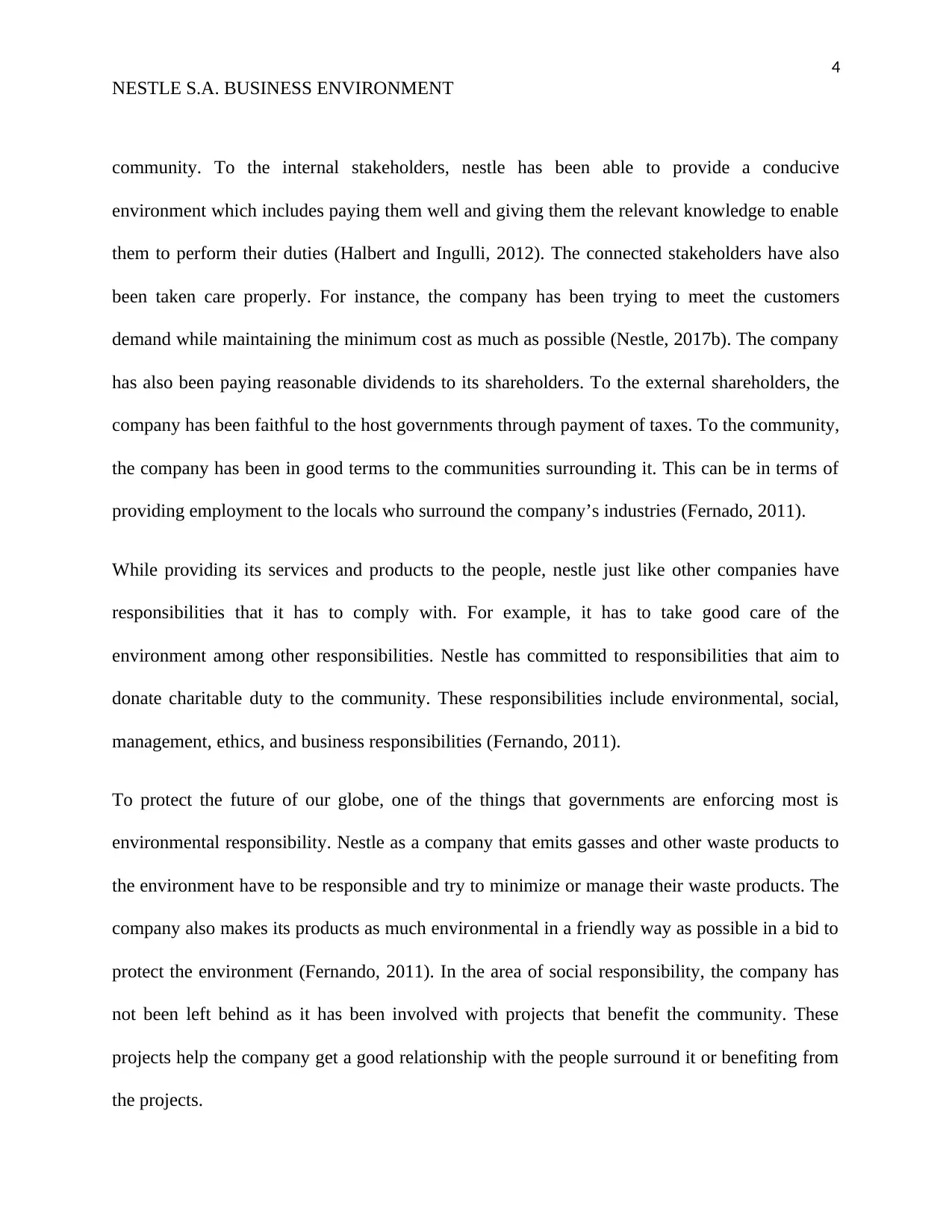
4
NESTLE S.A. BUSINESS ENVIRONMENT
community. To the internal stakeholders, nestle has been able to provide a conducive
environment which includes paying them well and giving them the relevant knowledge to enable
them to perform their duties (Halbert and Ingulli, 2012). The connected stakeholders have also
been taken care properly. For instance, the company has been trying to meet the customers
demand while maintaining the minimum cost as much as possible (Nestle, 2017b). The company
has also been paying reasonable dividends to its shareholders. To the external shareholders, the
company has been faithful to the host governments through payment of taxes. To the community,
the company has been in good terms to the communities surrounding it. This can be in terms of
providing employment to the locals who surround the company’s industries (Fernado, 2011).
While providing its services and products to the people, nestle just like other companies have
responsibilities that it has to comply with. For example, it has to take good care of the
environment among other responsibilities. Nestle has committed to responsibilities that aim to
donate charitable duty to the community. These responsibilities include environmental, social,
management, ethics, and business responsibilities (Fernando, 2011).
To protect the future of our globe, one of the things that governments are enforcing most is
environmental responsibility. Nestle as a company that emits gasses and other waste products to
the environment have to be responsible and try to minimize or manage their waste products. The
company also makes its products as much environmental in a friendly way as possible in a bid to
protect the environment (Fernando, 2011). In the area of social responsibility, the company has
not been left behind as it has been involved with projects that benefit the community. These
projects help the company get a good relationship with the people surround it or benefiting from
the projects.
NESTLE S.A. BUSINESS ENVIRONMENT
community. To the internal stakeholders, nestle has been able to provide a conducive
environment which includes paying them well and giving them the relevant knowledge to enable
them to perform their duties (Halbert and Ingulli, 2012). The connected stakeholders have also
been taken care properly. For instance, the company has been trying to meet the customers
demand while maintaining the minimum cost as much as possible (Nestle, 2017b). The company
has also been paying reasonable dividends to its shareholders. To the external shareholders, the
company has been faithful to the host governments through payment of taxes. To the community,
the company has been in good terms to the communities surrounding it. This can be in terms of
providing employment to the locals who surround the company’s industries (Fernado, 2011).
While providing its services and products to the people, nestle just like other companies have
responsibilities that it has to comply with. For example, it has to take good care of the
environment among other responsibilities. Nestle has committed to responsibilities that aim to
donate charitable duty to the community. These responsibilities include environmental, social,
management, ethics, and business responsibilities (Fernando, 2011).
To protect the future of our globe, one of the things that governments are enforcing most is
environmental responsibility. Nestle as a company that emits gasses and other waste products to
the environment have to be responsible and try to minimize or manage their waste products. The
company also makes its products as much environmental in a friendly way as possible in a bid to
protect the environment (Fernando, 2011). In the area of social responsibility, the company has
not been left behind as it has been involved with projects that benefit the community. These
projects help the company get a good relationship with the people surround it or benefiting from
the projects.
Paraphrase This Document
Need a fresh take? Get an instant paraphrase of this document with our AI Paraphraser
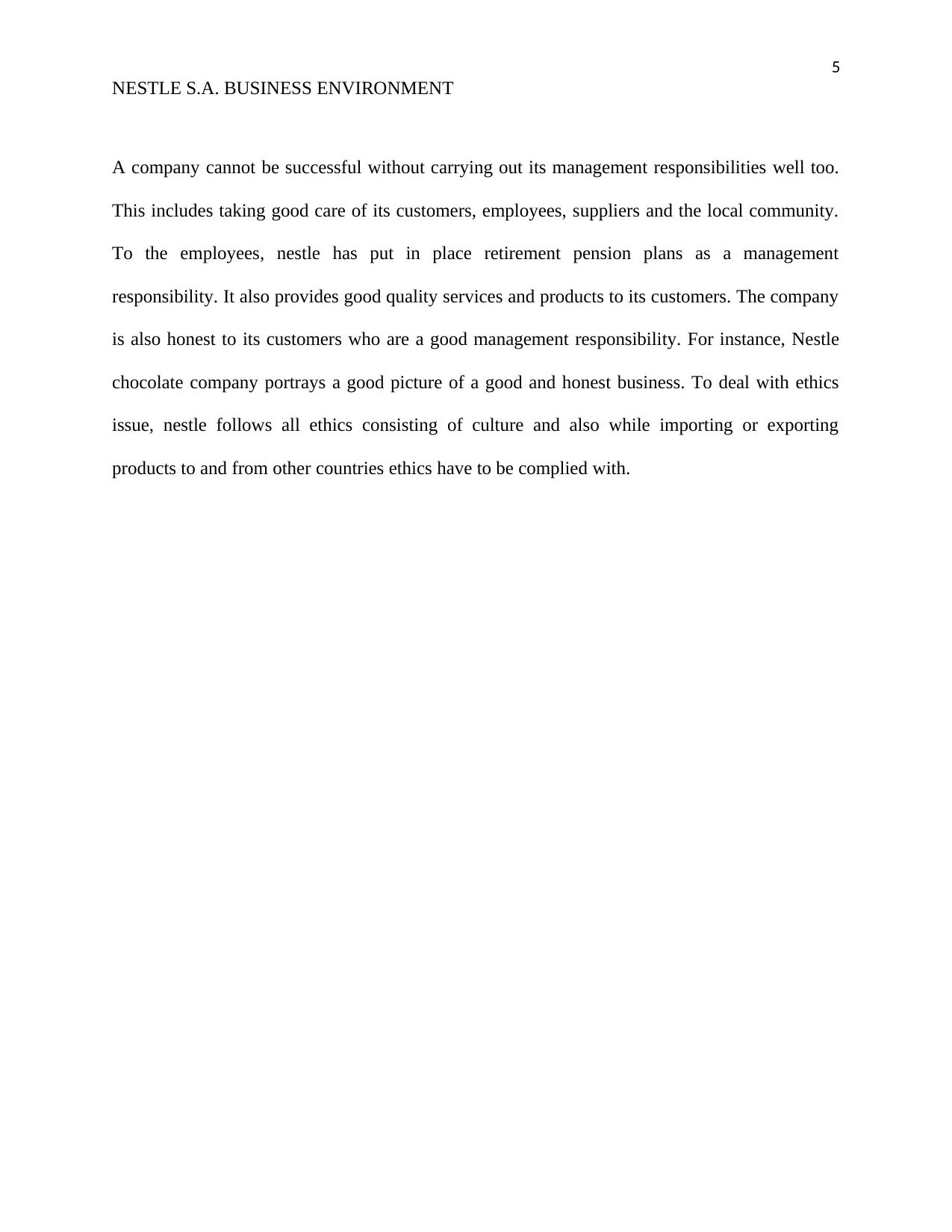
5
NESTLE S.A. BUSINESS ENVIRONMENT
A company cannot be successful without carrying out its management responsibilities well too.
This includes taking good care of its customers, employees, suppliers and the local community.
To the employees, nestle has put in place retirement pension plans as a management
responsibility. It also provides good quality services and products to its customers. The company
is also honest to its customers who are a good management responsibility. For instance, Nestle
chocolate company portrays a good picture of a good and honest business. To deal with ethics
issue, nestle follows all ethics consisting of culture and also while importing or exporting
products to and from other countries ethics have to be complied with.
NESTLE S.A. BUSINESS ENVIRONMENT
A company cannot be successful without carrying out its management responsibilities well too.
This includes taking good care of its customers, employees, suppliers and the local community.
To the employees, nestle has put in place retirement pension plans as a management
responsibility. It also provides good quality services and products to its customers. The company
is also honest to its customers who are a good management responsibility. For instance, Nestle
chocolate company portrays a good picture of a good and honest business. To deal with ethics
issue, nestle follows all ethics consisting of culture and also while importing or exporting
products to and from other countries ethics have to be complied with.
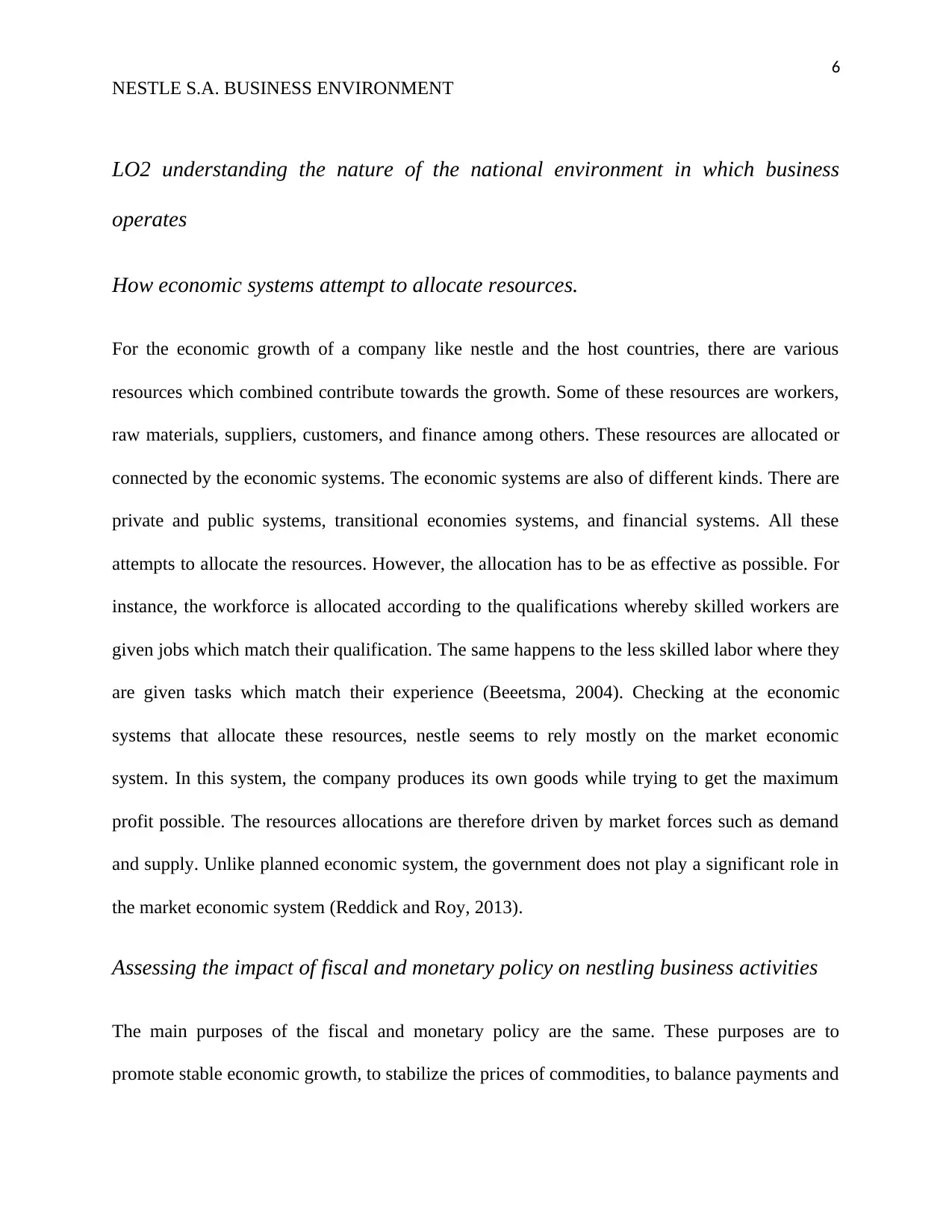
6
NESTLE S.A. BUSINESS ENVIRONMENT
LO2 understanding the nature of the national environment in which business
operates
How economic systems attempt to allocate resources.
For the economic growth of a company like nestle and the host countries, there are various
resources which combined contribute towards the growth. Some of these resources are workers,
raw materials, suppliers, customers, and finance among others. These resources are allocated or
connected by the economic systems. The economic systems are also of different kinds. There are
private and public systems, transitional economies systems, and financial systems. All these
attempts to allocate the resources. However, the allocation has to be as effective as possible. For
instance, the workforce is allocated according to the qualifications whereby skilled workers are
given jobs which match their qualification. The same happens to the less skilled labor where they
are given tasks which match their experience (Beeetsma, 2004). Checking at the economic
systems that allocate these resources, nestle seems to rely mostly on the market economic
system. In this system, the company produces its own goods while trying to get the maximum
profit possible. The resources allocations are therefore driven by market forces such as demand
and supply. Unlike planned economic system, the government does not play a significant role in
the market economic system (Reddick and Roy, 2013).
Assessing the impact of fiscal and monetary policy on nestling business activities
The main purposes of the fiscal and monetary policy are the same. These purposes are to
promote stable economic growth, to stabilize the prices of commodities, to balance payments and
NESTLE S.A. BUSINESS ENVIRONMENT
LO2 understanding the nature of the national environment in which business
operates
How economic systems attempt to allocate resources.
For the economic growth of a company like nestle and the host countries, there are various
resources which combined contribute towards the growth. Some of these resources are workers,
raw materials, suppliers, customers, and finance among others. These resources are allocated or
connected by the economic systems. The economic systems are also of different kinds. There are
private and public systems, transitional economies systems, and financial systems. All these
attempts to allocate the resources. However, the allocation has to be as effective as possible. For
instance, the workforce is allocated according to the qualifications whereby skilled workers are
given jobs which match their qualification. The same happens to the less skilled labor where they
are given tasks which match their experience (Beeetsma, 2004). Checking at the economic
systems that allocate these resources, nestle seems to rely mostly on the market economic
system. In this system, the company produces its own goods while trying to get the maximum
profit possible. The resources allocations are therefore driven by market forces such as demand
and supply. Unlike planned economic system, the government does not play a significant role in
the market economic system (Reddick and Roy, 2013).
Assessing the impact of fiscal and monetary policy on nestling business activities
The main purposes of the fiscal and monetary policy are the same. These purposes are to
promote stable economic growth, to stabilize the prices of commodities, to balance payments and
⊘ This is a preview!⊘
Do you want full access?
Subscribe today to unlock all pages.

Trusted by 1+ million students worldwide
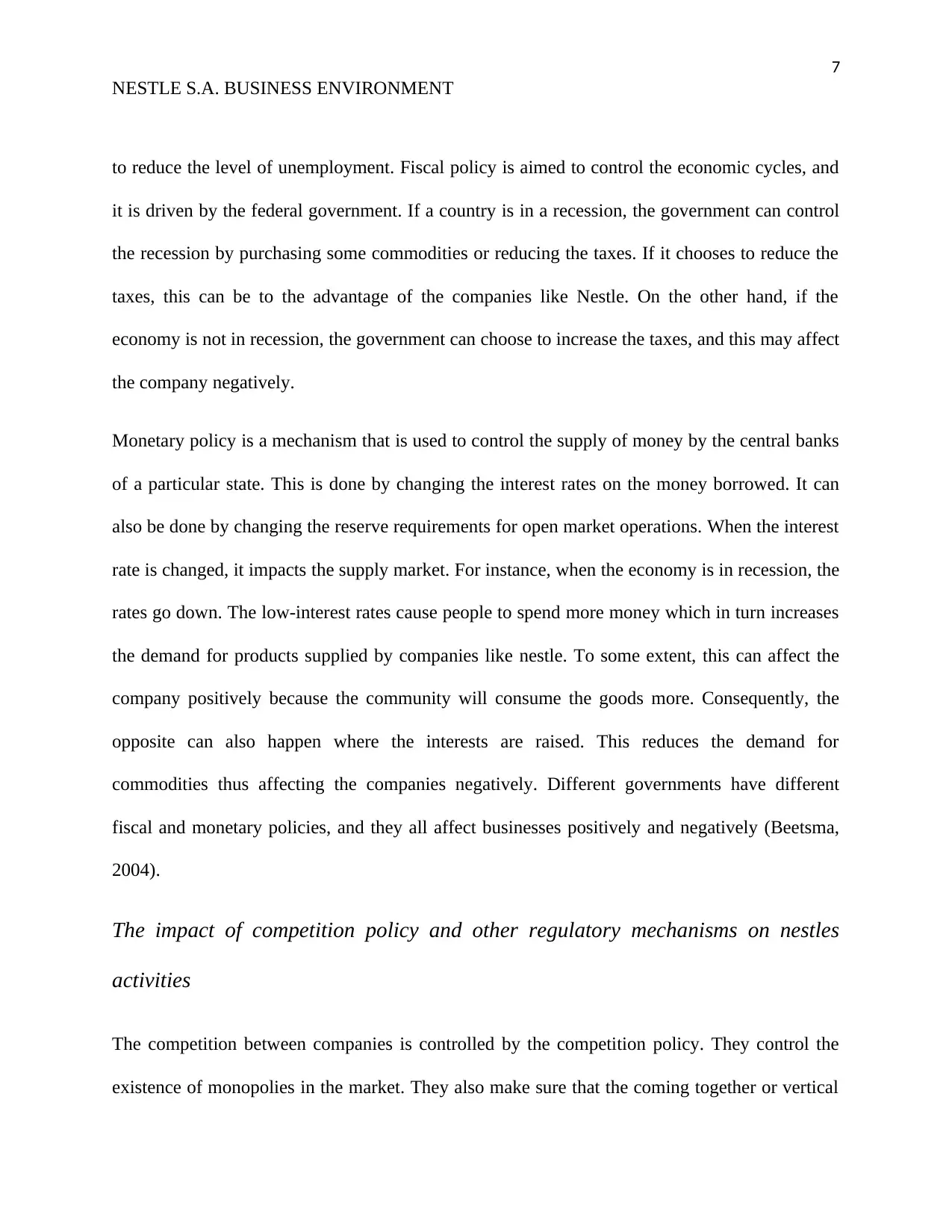
7
NESTLE S.A. BUSINESS ENVIRONMENT
to reduce the level of unemployment. Fiscal policy is aimed to control the economic cycles, and
it is driven by the federal government. If a country is in a recession, the government can control
the recession by purchasing some commodities or reducing the taxes. If it chooses to reduce the
taxes, this can be to the advantage of the companies like Nestle. On the other hand, if the
economy is not in recession, the government can choose to increase the taxes, and this may affect
the company negatively.
Monetary policy is a mechanism that is used to control the supply of money by the central banks
of a particular state. This is done by changing the interest rates on the money borrowed. It can
also be done by changing the reserve requirements for open market operations. When the interest
rate is changed, it impacts the supply market. For instance, when the economy is in recession, the
rates go down. The low-interest rates cause people to spend more money which in turn increases
the demand for products supplied by companies like nestle. To some extent, this can affect the
company positively because the community will consume the goods more. Consequently, the
opposite can also happen where the interests are raised. This reduces the demand for
commodities thus affecting the companies negatively. Different governments have different
fiscal and monetary policies, and they all affect businesses positively and negatively (Beetsma,
2004).
The impact of competition policy and other regulatory mechanisms on nestles
activities
The competition between companies is controlled by the competition policy. They control the
existence of monopolies in the market. They also make sure that the coming together or vertical
NESTLE S.A. BUSINESS ENVIRONMENT
to reduce the level of unemployment. Fiscal policy is aimed to control the economic cycles, and
it is driven by the federal government. If a country is in a recession, the government can control
the recession by purchasing some commodities or reducing the taxes. If it chooses to reduce the
taxes, this can be to the advantage of the companies like Nestle. On the other hand, if the
economy is not in recession, the government can choose to increase the taxes, and this may affect
the company negatively.
Monetary policy is a mechanism that is used to control the supply of money by the central banks
of a particular state. This is done by changing the interest rates on the money borrowed. It can
also be done by changing the reserve requirements for open market operations. When the interest
rate is changed, it impacts the supply market. For instance, when the economy is in recession, the
rates go down. The low-interest rates cause people to spend more money which in turn increases
the demand for products supplied by companies like nestle. To some extent, this can affect the
company positively because the community will consume the goods more. Consequently, the
opposite can also happen where the interests are raised. This reduces the demand for
commodities thus affecting the companies negatively. Different governments have different
fiscal and monetary policies, and they all affect businesses positively and negatively (Beetsma,
2004).
The impact of competition policy and other regulatory mechanisms on nestles
activities
The competition between companies is controlled by the competition policy. They control the
existence of monopolies in the market. They also make sure that the coming together or vertical
Paraphrase This Document
Need a fresh take? Get an instant paraphrase of this document with our AI Paraphraser
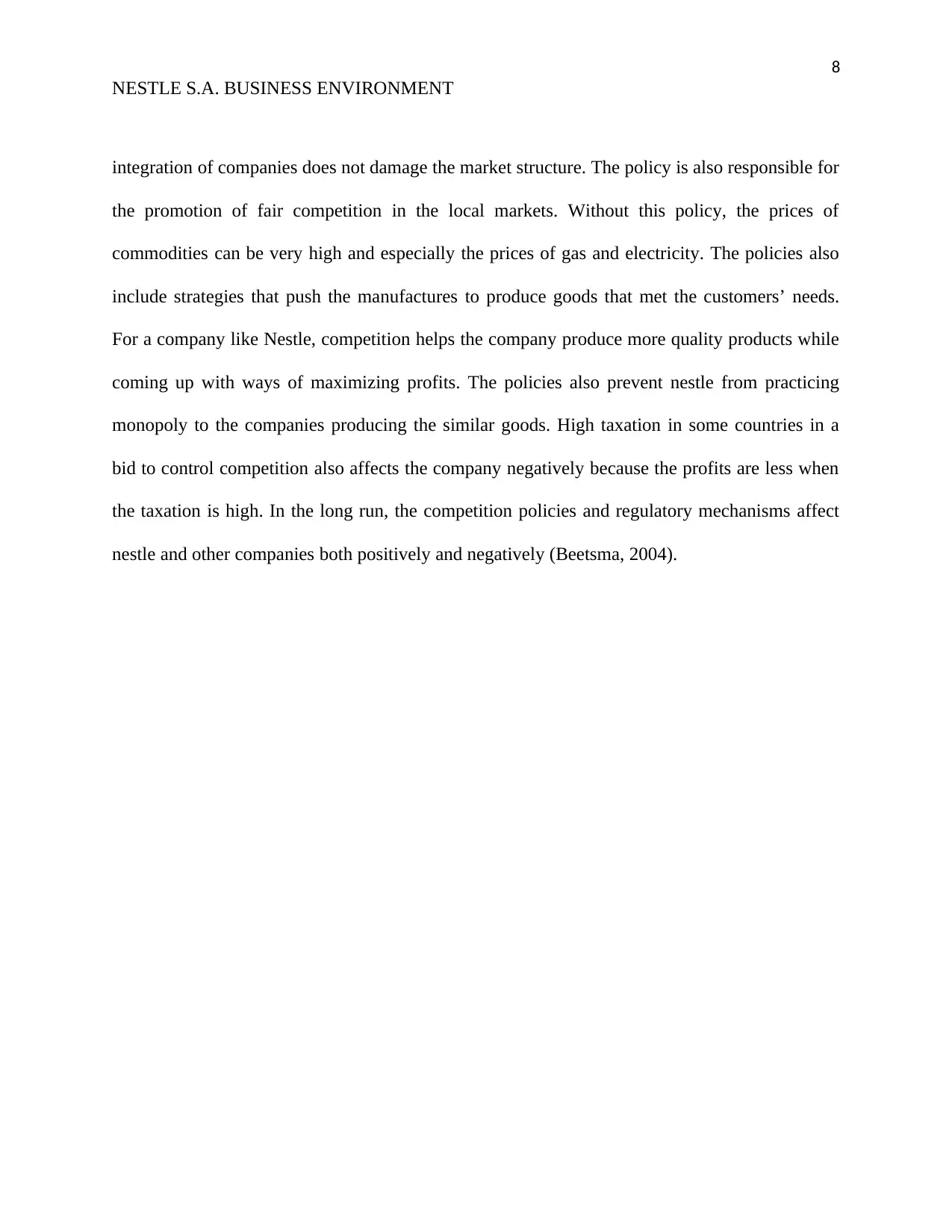
8
NESTLE S.A. BUSINESS ENVIRONMENT
integration of companies does not damage the market structure. The policy is also responsible for
the promotion of fair competition in the local markets. Without this policy, the prices of
commodities can be very high and especially the prices of gas and electricity. The policies also
include strategies that push the manufactures to produce goods that met the customers’ needs.
For a company like Nestle, competition helps the company produce more quality products while
coming up with ways of maximizing profits. The policies also prevent nestle from practicing
monopoly to the companies producing the similar goods. High taxation in some countries in a
bid to control competition also affects the company negatively because the profits are less when
the taxation is high. In the long run, the competition policies and regulatory mechanisms affect
nestle and other companies both positively and negatively (Beetsma, 2004).
NESTLE S.A. BUSINESS ENVIRONMENT
integration of companies does not damage the market structure. The policy is also responsible for
the promotion of fair competition in the local markets. Without this policy, the prices of
commodities can be very high and especially the prices of gas and electricity. The policies also
include strategies that push the manufactures to produce goods that met the customers’ needs.
For a company like Nestle, competition helps the company produce more quality products while
coming up with ways of maximizing profits. The policies also prevent nestle from practicing
monopoly to the companies producing the similar goods. High taxation in some countries in a
bid to control competition also affects the company negatively because the profits are less when
the taxation is high. In the long run, the competition policies and regulatory mechanisms affect
nestle and other companies both positively and negatively (Beetsma, 2004).
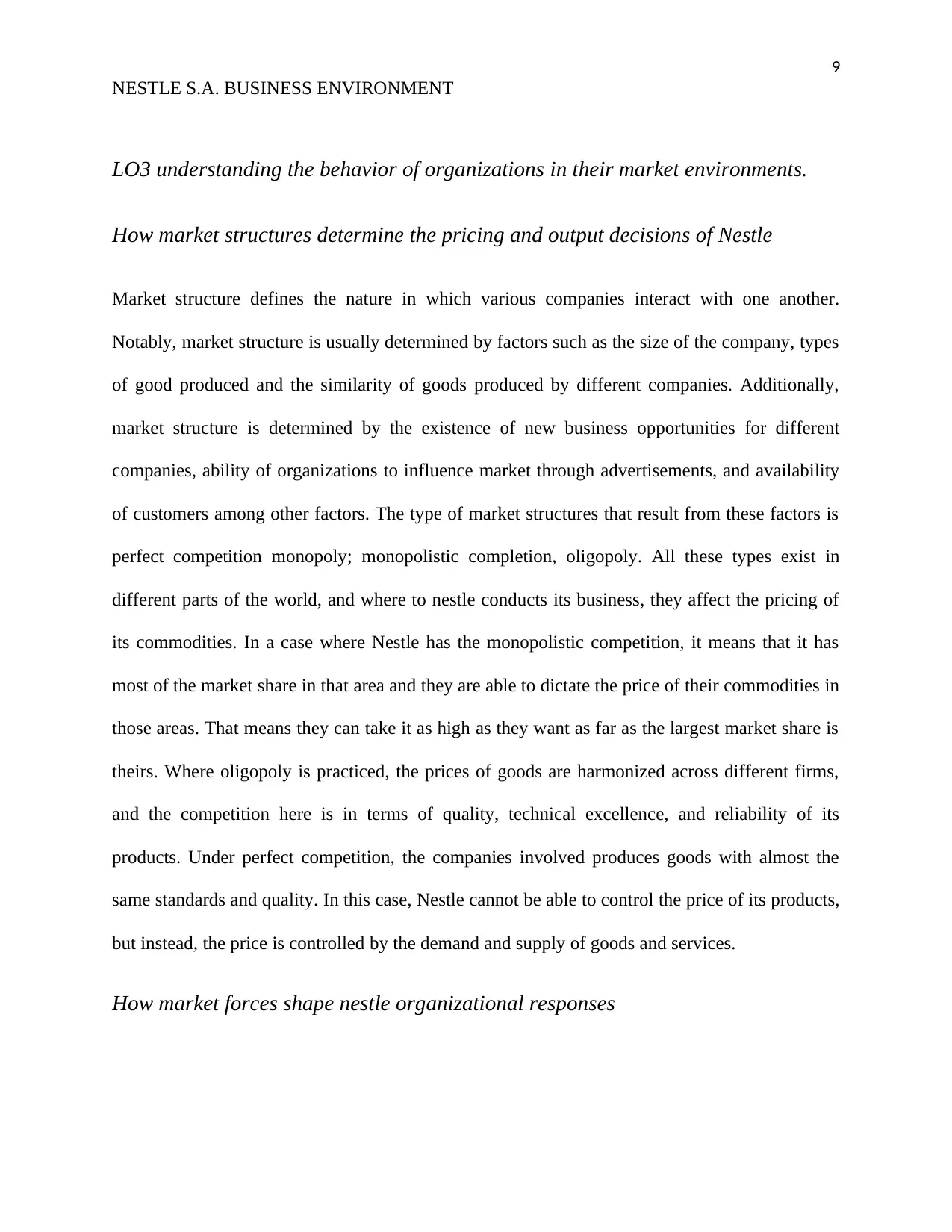
9
NESTLE S.A. BUSINESS ENVIRONMENT
LO3 understanding the behavior of organizations in their market environments.
How market structures determine the pricing and output decisions of Nestle
Market structure defines the nature in which various companies interact with one another.
Notably, market structure is usually determined by factors such as the size of the company, types
of good produced and the similarity of goods produced by different companies. Additionally,
market structure is determined by the existence of new business opportunities for different
companies, ability of organizations to influence market through advertisements, and availability
of customers among other factors. The type of market structures that result from these factors is
perfect competition monopoly; monopolistic completion, oligopoly. All these types exist in
different parts of the world, and where to nestle conducts its business, they affect the pricing of
its commodities. In a case where Nestle has the monopolistic competition, it means that it has
most of the market share in that area and they are able to dictate the price of their commodities in
those areas. That means they can take it as high as they want as far as the largest market share is
theirs. Where oligopoly is practiced, the prices of goods are harmonized across different firms,
and the competition here is in terms of quality, technical excellence, and reliability of its
products. Under perfect competition, the companies involved produces goods with almost the
same standards and quality. In this case, Nestle cannot be able to control the price of its products,
but instead, the price is controlled by the demand and supply of goods and services.
How market forces shape nestle organizational responses
NESTLE S.A. BUSINESS ENVIRONMENT
LO3 understanding the behavior of organizations in their market environments.
How market structures determine the pricing and output decisions of Nestle
Market structure defines the nature in which various companies interact with one another.
Notably, market structure is usually determined by factors such as the size of the company, types
of good produced and the similarity of goods produced by different companies. Additionally,
market structure is determined by the existence of new business opportunities for different
companies, ability of organizations to influence market through advertisements, and availability
of customers among other factors. The type of market structures that result from these factors is
perfect competition monopoly; monopolistic completion, oligopoly. All these types exist in
different parts of the world, and where to nestle conducts its business, they affect the pricing of
its commodities. In a case where Nestle has the monopolistic competition, it means that it has
most of the market share in that area and they are able to dictate the price of their commodities in
those areas. That means they can take it as high as they want as far as the largest market share is
theirs. Where oligopoly is practiced, the prices of goods are harmonized across different firms,
and the competition here is in terms of quality, technical excellence, and reliability of its
products. Under perfect competition, the companies involved produces goods with almost the
same standards and quality. In this case, Nestle cannot be able to control the price of its products,
but instead, the price is controlled by the demand and supply of goods and services.
How market forces shape nestle organizational responses
⊘ This is a preview!⊘
Do you want full access?
Subscribe today to unlock all pages.

Trusted by 1+ million students worldwide
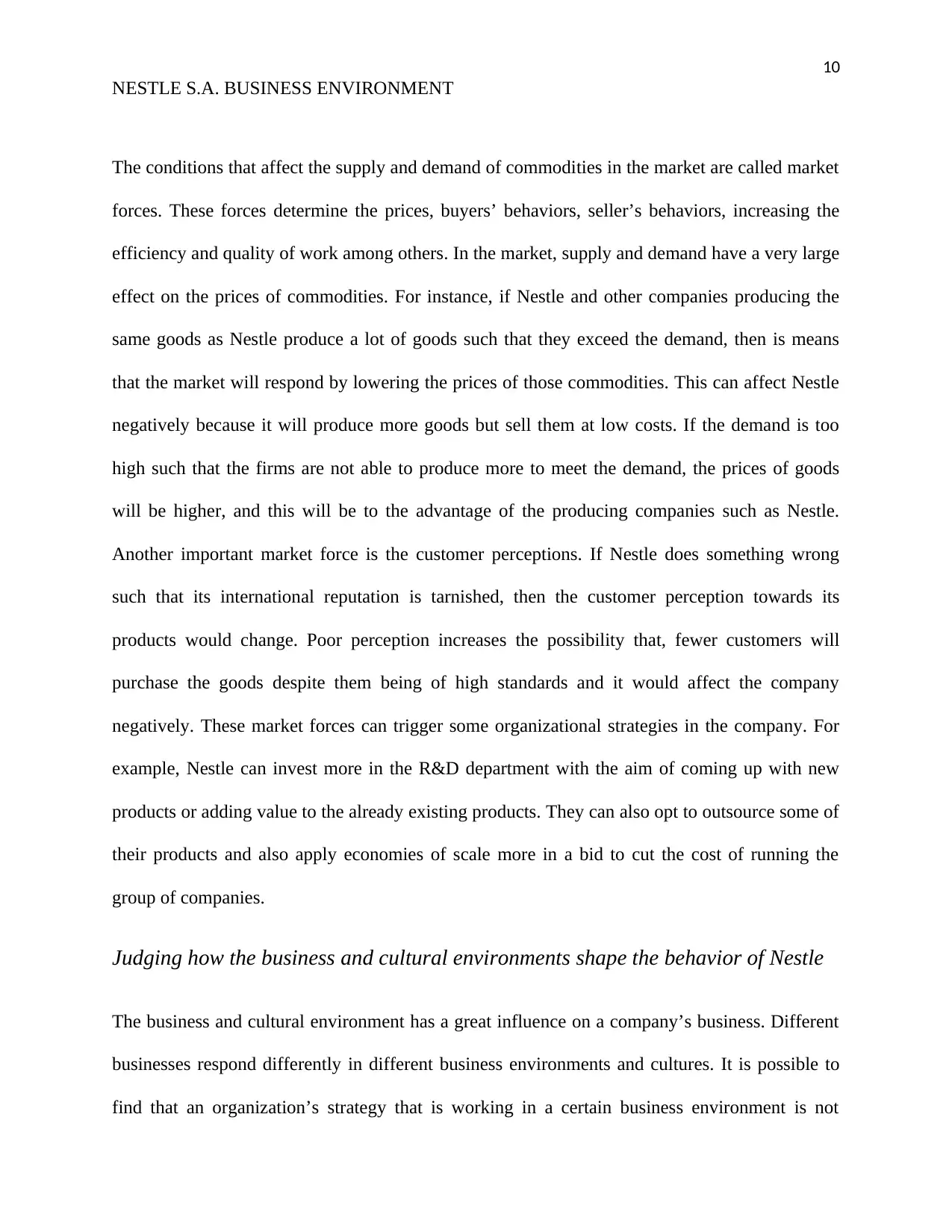
10
NESTLE S.A. BUSINESS ENVIRONMENT
The conditions that affect the supply and demand of commodities in the market are called market
forces. These forces determine the prices, buyers’ behaviors, seller’s behaviors, increasing the
efficiency and quality of work among others. In the market, supply and demand have a very large
effect on the prices of commodities. For instance, if Nestle and other companies producing the
same goods as Nestle produce a lot of goods such that they exceed the demand, then is means
that the market will respond by lowering the prices of those commodities. This can affect Nestle
negatively because it will produce more goods but sell them at low costs. If the demand is too
high such that the firms are not able to produce more to meet the demand, the prices of goods
will be higher, and this will be to the advantage of the producing companies such as Nestle.
Another important market force is the customer perceptions. If Nestle does something wrong
such that its international reputation is tarnished, then the customer perception towards its
products would change. Poor perception increases the possibility that, fewer customers will
purchase the goods despite them being of high standards and it would affect the company
negatively. These market forces can trigger some organizational strategies in the company. For
example, Nestle can invest more in the R&D department with the aim of coming up with new
products or adding value to the already existing products. They can also opt to outsource some of
their products and also apply economies of scale more in a bid to cut the cost of running the
group of companies.
Judging how the business and cultural environments shape the behavior of Nestle
The business and cultural environment has a great influence on a company’s business. Different
businesses respond differently in different business environments and cultures. It is possible to
find that an organization’s strategy that is working in a certain business environment is not
NESTLE S.A. BUSINESS ENVIRONMENT
The conditions that affect the supply and demand of commodities in the market are called market
forces. These forces determine the prices, buyers’ behaviors, seller’s behaviors, increasing the
efficiency and quality of work among others. In the market, supply and demand have a very large
effect on the prices of commodities. For instance, if Nestle and other companies producing the
same goods as Nestle produce a lot of goods such that they exceed the demand, then is means
that the market will respond by lowering the prices of those commodities. This can affect Nestle
negatively because it will produce more goods but sell them at low costs. If the demand is too
high such that the firms are not able to produce more to meet the demand, the prices of goods
will be higher, and this will be to the advantage of the producing companies such as Nestle.
Another important market force is the customer perceptions. If Nestle does something wrong
such that its international reputation is tarnished, then the customer perception towards its
products would change. Poor perception increases the possibility that, fewer customers will
purchase the goods despite them being of high standards and it would affect the company
negatively. These market forces can trigger some organizational strategies in the company. For
example, Nestle can invest more in the R&D department with the aim of coming up with new
products or adding value to the already existing products. They can also opt to outsource some of
their products and also apply economies of scale more in a bid to cut the cost of running the
group of companies.
Judging how the business and cultural environments shape the behavior of Nestle
The business and cultural environment has a great influence on a company’s business. Different
businesses respond differently in different business environments and cultures. It is possible to
find that an organization’s strategy that is working in a certain business environment is not
Paraphrase This Document
Need a fresh take? Get an instant paraphrase of this document with our AI Paraphraser
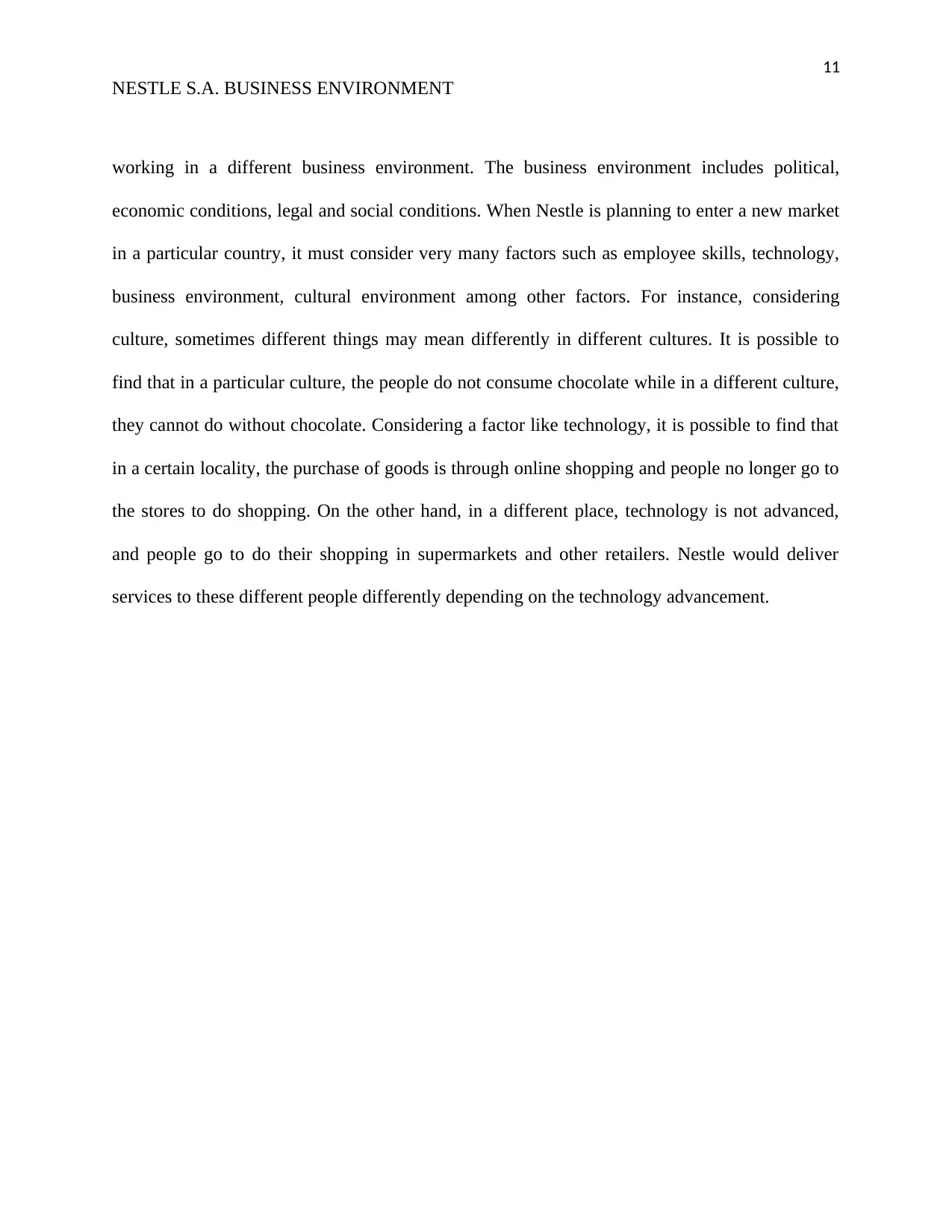
11
NESTLE S.A. BUSINESS ENVIRONMENT
working in a different business environment. The business environment includes political,
economic conditions, legal and social conditions. When Nestle is planning to enter a new market
in a particular country, it must consider very many factors such as employee skills, technology,
business environment, cultural environment among other factors. For instance, considering
culture, sometimes different things may mean differently in different cultures. It is possible to
find that in a particular culture, the people do not consume chocolate while in a different culture,
they cannot do without chocolate. Considering a factor like technology, it is possible to find that
in a certain locality, the purchase of goods is through online shopping and people no longer go to
the stores to do shopping. On the other hand, in a different place, technology is not advanced,
and people go to do their shopping in supermarkets and other retailers. Nestle would deliver
services to these different people differently depending on the technology advancement.
NESTLE S.A. BUSINESS ENVIRONMENT
working in a different business environment. The business environment includes political,
economic conditions, legal and social conditions. When Nestle is planning to enter a new market
in a particular country, it must consider very many factors such as employee skills, technology,
business environment, cultural environment among other factors. For instance, considering
culture, sometimes different things may mean differently in different cultures. It is possible to
find that in a particular culture, the people do not consume chocolate while in a different culture,
they cannot do without chocolate. Considering a factor like technology, it is possible to find that
in a certain locality, the purchase of goods is through online shopping and people no longer go to
the stores to do shopping. On the other hand, in a different place, technology is not advanced,
and people go to do their shopping in supermarkets and other retailers. Nestle would deliver
services to these different people differently depending on the technology advancement.

12
NESTLE S.A. BUSINESS ENVIRONMENT
LO4 assessing the significance of the global factors that shape national business
activities
Significance of international trade to Nestle as a UK business organization
The exchange of goods and services between countries is known as international trade. It is
through this that a company like Nestle is able to sell its products all over the world as well as
import some raw materials essential in their production. As more countries develop, more market
opportunities for Nestle products are created. When more markets are created, it means more
revenue and could be more profits. However, international trade is not just conducted anyhow as
it is regulated by world trade organization (WTO). This organization is responsible for the
development of trade agreements and also following to make sure that they are implemented.
This organization affects companies like nestle in that it improves performance while allowing
countries to participate in the global economy.
Impact of global factors on Nestle as a UK business organization
Just like other businesses are affected either positively or negatively by global factors, Nestle is
also affected. The UK being among the leading countries in the exportation of services and
importation of goods, the businesses conducted there are highly affected by the global factors.
These factors could include business environments, competition, science and technology,
exchange rates, labor costs, taxation regimes among other factors. They all affect the company
either positively or negatively. For instance, if a taxation of a certain country where Nestle
exports its goods or gets its raw materials from is very high, then it means conducting business
NESTLE S.A. BUSINESS ENVIRONMENT
LO4 assessing the significance of the global factors that shape national business
activities
Significance of international trade to Nestle as a UK business organization
The exchange of goods and services between countries is known as international trade. It is
through this that a company like Nestle is able to sell its products all over the world as well as
import some raw materials essential in their production. As more countries develop, more market
opportunities for Nestle products are created. When more markets are created, it means more
revenue and could be more profits. However, international trade is not just conducted anyhow as
it is regulated by world trade organization (WTO). This organization is responsible for the
development of trade agreements and also following to make sure that they are implemented.
This organization affects companies like nestle in that it improves performance while allowing
countries to participate in the global economy.
Impact of global factors on Nestle as a UK business organization
Just like other businesses are affected either positively or negatively by global factors, Nestle is
also affected. The UK being among the leading countries in the exportation of services and
importation of goods, the businesses conducted there are highly affected by the global factors.
These factors could include business environments, competition, science and technology,
exchange rates, labor costs, taxation regimes among other factors. They all affect the company
either positively or negatively. For instance, if a taxation of a certain country where Nestle
exports its goods or gets its raw materials from is very high, then it means conducting business
⊘ This is a preview!⊘
Do you want full access?
Subscribe today to unlock all pages.

Trusted by 1+ million students worldwide
1 out of 15
Related Documents
Your All-in-One AI-Powered Toolkit for Academic Success.
+13062052269
info@desklib.com
Available 24*7 on WhatsApp / Email
![[object Object]](/_next/static/media/star-bottom.7253800d.svg)
Unlock your academic potential
Copyright © 2020–2025 A2Z Services. All Rights Reserved. Developed and managed by ZUCOL.





